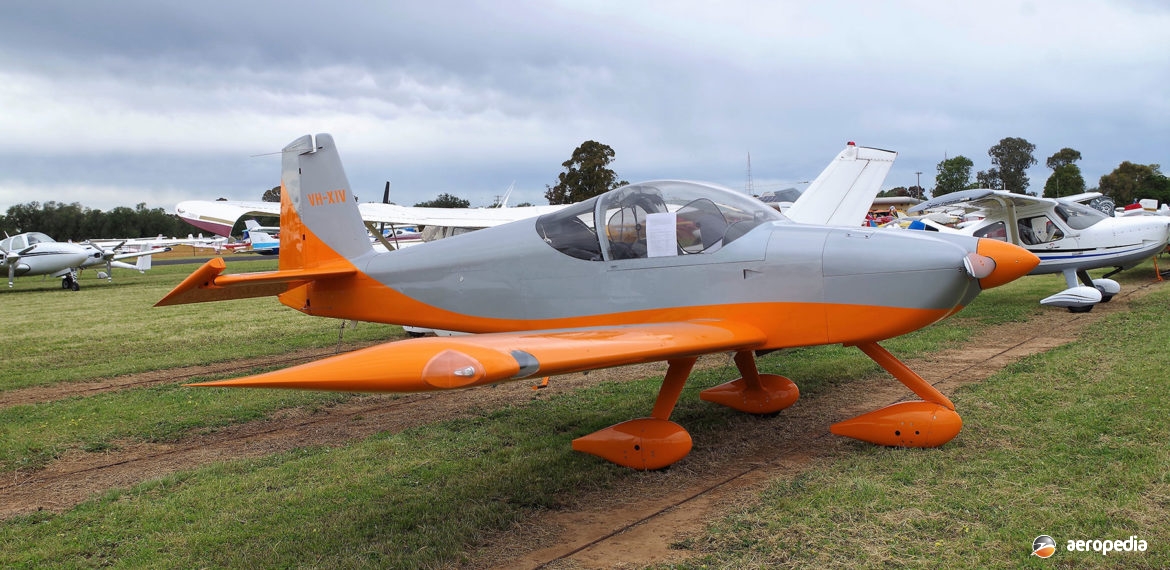Photograph:
Vans RV-14A VH-XIV (c/n 149) at OzKosh at Narromine, NSW in October 2016 (David C Eyre)
Country of origin:
United States of America
Description:
Two-seat light sport monoplane
Power Plant:
One 157 kw (210 hp) Lycoming IO-390A3B6 four-cylinder horizontally-opposed air-cooled engine
Specifications:
- Wingspan: 8.22 m (27 ft)
- Length: 6.43 m (21 ft 1 in)
- Height: 2.5 m (8 ft 2 in)
- Wing area: 11.71 m² (126.1 sq ft)
- Max speed: 327 km/h (203 mph)
- Cruising speed at 2,438 m (8,000 ft) at 75% power: 311 km/h (193 mph)
- Cruising speed at 2,438 m (8,000 ft) at 55% power: 272 km/h (169 mph)
- Stalling speed: 90 km/h (56 mph)
- Take-off distance: 192 m (630 ft)
- Landing distance: 218 m (715 ft)
- Rate of climb: 457 m (1,500 ft/min)
- Ceiling: 5,486 m (18,000 ft)
- Range at 75% power: 1,489 m (925 miles)
- Range at 55% power: 1,738 km (1,080 miles)
- Fuel capacity: 189 litres (42 Imp gals)
- Empty weight: 562 kg (1,240 lb)
- Loaded weight: 930 kg (2,050 lb)
History:
The Vans RV-14 and RV-14A series was introduced to the sporting aviation market in 2012 and, although similar in appearance to other aircraft in the series, is better described as a two-seat variant of the RV-10 series capable of some aerobatics. The wing is similar to that of the RV-10 but is 1.22 m (4 ft) shorter and the ailerons remain the same. The flaps are smaller, and aerodynamically the tail is similar to the RV-9. The aircraft is available in kit form and has been designed for modularity, electrical harnesses, sub-kits and other components being designed to ease the time to build the aircraft and accommodate a range of optional equipment.
The aircraft is a two-seater and is available to be constructed with a tailwheel (RV-14) or tricycle undercarriage (RV-14A). Baggage space is available behind the two seats for 45 kg (100 lb). Power is usually provided by a Lycoming IO-390 engine driving a Hartzell propeller. The wing is a constant chord and constant thickness, and has slotted flaps for ease of construction. The leading-edge fuel tanks can be removed without removing the wing from the aircraft and the ailerons are controlled by rigid pushrods moving on bearings and bushings.
The airframe is monocoque held together with rivets. The wing and slotted flaps allow the aircraft to have short field capability and it can operate from grass, dirt or gravel runways. With a full fuel load, 231 kg (510 lb) is available for two persons in the cockpit and baggage. Cruising at 70% power at 306 km/h (190 mph) it has a max range of 2,593 km (1,611 miles).
A number of kits have been imported to Australasia, the first registered, an RV-14A, becoming VH-XIV (c/n 149) to Mr Alan Carlisle, this aircraft being fitted with a Lycoming YIO-390EXP10 engine; followed by RV-14A VH-JBR³ (c/n 140038) on 25 February 2016 to its owner at Mildura, VIC; VH-RMV4 (c/n 140010) registered to its owner at Tully, QLD; and VH-VNX (c/n 140331) on 2 March 2018.
The Vans series of kit aircraft has been very popular around the world and the 10,000th aircraft completed was flown on 25 November 2017 in Virginia, USA. By mid-December that year 10,026 had been built, the most popular models being the RV-6 and RV-7 of which 4,297 had been completed.

